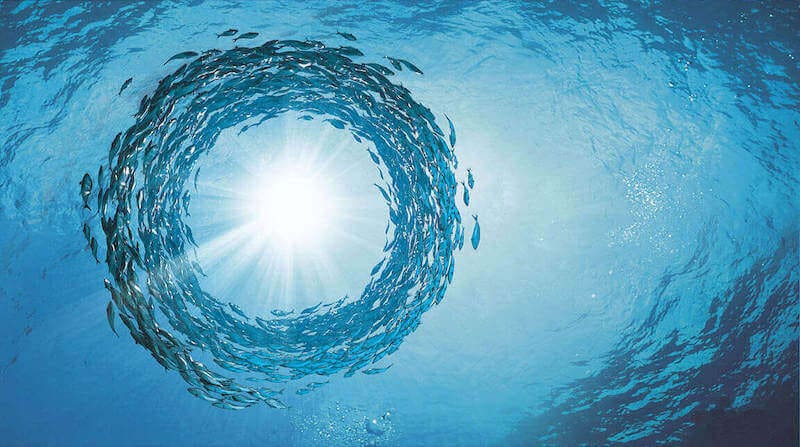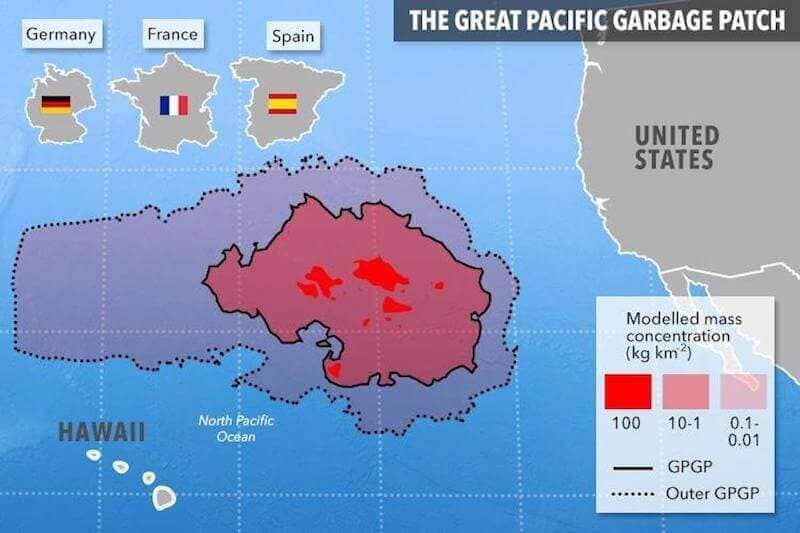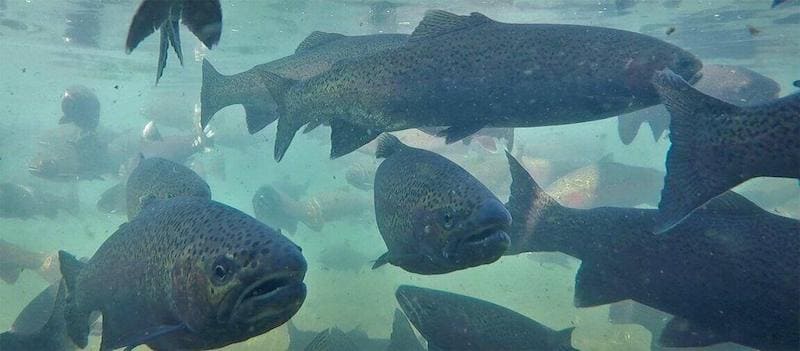
Incentivized by government subsidies, growing fish as a commercial occupation has grown, particularly overseas where most fish imported into the U.S. and Europe are farmed. The hope is that domestic fish production will increase, and more Americans will be growing fish in country and lower overseas imports. The industry is facing headwinds, however due to disease outbreaks among penned fish and the accidental release of farmed fish into the surrounding ocean infecting wild stock.
Crop Circle Fisheries uses propagation technologies developed by Crop Circle Farms ® to grow fish. Spiraled fish tanks, artificial rivers, closed fiords and manmade closed river systems are just a few of the ways Crop Circle Farms is growing fish. Crop Circle Fisheries mimics river and ocean environments to raise fish as naturally as possible. Stressed fish are prone to disease and have less market value at harvest.

Millions of fish are dying all over the planet. The world’s fish stocks are “on the verge of collapse,” according to a special report from IRIN, the International Union for Conservation of Nature. There are plenty of reasons for this; overfishing, destruction of spawning grounds, increasing water temperatures, disease, and algae bloom. An estimated 70 percent of fish populations are fully used, overused, or in crisis because of overfishing and warmer waters. If the current rate of fishing continues, we will be out of fish by 2050 according to the IRIN.
Many Scientists Believe We Are Witnessing An Extinction Event
It’s happened before; the geological record reveals several major extinction events in our past including the one that killed of the dinosaurs and 90% of all life on the planet. In that case, it seems a meteor strike was the cause, but what about now?
Radiation Continues To Flow From The Fukushima Nuclear Power Plant
After an earthquake damaged the plant in 2011, radiation still flows into the Pacific Ocean. By the end of 2014, three years after the disaster, radiation had spread into the entire North Pacific Ocean, transported by the North Pacific current from Japan to the Gulf of Alaska. In 2018 it spread to the South Pacific Ocean to Chile and Antarctica. Commercial fishermen report huge “dead zones” where there is no life at all, not even birds.
Most have heard of a large plastic garbage island floating in the middle of the Pacific Ocean. That was a decade ago, now there are two of them; one called the Pacific Garbage Island and the other the Western Garbage Island. A third one is forming between the two of them in the Subtropical Convergence Zone, located about a thousand nautical miles north of Hawaii. The islands are formed by the dumping of plastic trash into the ocean by cities all along the Pacific coast. The biggest of the floating dumps is larger than Germany, France and Spain combined and it’s still growing.
It’s The Small Bits That Do The Most Damage
What’s not readily seen that does the most damage to fish; tiny bits of plastic known as micro plastics that make the surface of the ocean look like soup, growing fish that ingest these particles die within months. Scientists fear that what’s floating on the surface represents a small portion of the debris. The sea floor beneath the Great Pacific Garbage Patch may also be an underwater trash heap. Oceanographers and ecologists recently discovered that about 70% of marine debris sinks to the bottom of the ocean where it kills off life on the ocean floor.

It’s not just happening in our oceans; dead fish are washing up on the shores of lakes all over the world due to years of industrial pollution and warmer water caused by climate change. Some scientists believe changes in the earth’s magnetic field are partially responsible - the Magnetic North Pole has moved some 500 miles the last 30 years.
Penned fish farming — also known as aquaculture — is generally big, dirty, and dangerous, not too different from factory farming on land. Around half of the seafood eaten in the entire world is grown in man-made cages. To produce fish as cheaply as possible, massive amounts of antibiotics, hormones, and pesticides are needed to keep fish alive in overcrowded conditions (typically growing fish in nets, cages, or shallow ponds). The risk of contamination is high, both to the surrounding water and within the fish pens themselves. For the last 50 years, multi-national corporations have been changing the way we grow plants and animals on land and now are posited to the same with fish. The factory farms that grow beef and chickens around the world are being considered as a model to grow fish on land. As with factory farms on land, growing fish in pens or tanks on land presents several environmental problems, including:
The ecological consequences of cultivating fish in cages or tanks can be considerable, necessitating the development of more sustainable and conscientious methods to lessen these effects.
Governments are scrambling to develop better alternatives to growing fish using tank aquaculture, including Recirculating Aquaculture Systems (RAS). RAS closed-looped, and bio secure aquaculture operations avoid many of the contamination potential inherent in current factory fish farming and fulfill the need for clean, sustainable, and healthy fish to supplement depleted wild fisheries. Crop Circle Fisheries is one of the best representatives for growing fish using alternative system aquaculture.

Crop Circle Fisheries grow large sustainable fish populations by shaping the natural earth environment into wide trench, closed loop spirals, artificial rivers which increase the earth’s magnetic field to benefit growing fish. The amplified field magnetizes the water, increasing oxygen absorption at a molecular level, which eliminates the need for supplement supply generated by a fossil fueled aerator. High oxygen levels keep disease and algae in check and provide an environment where a natural food supply can develop for growing fish to feed on. Instead of a factory fish farm growing one species of fish, many fish species can co-grow in crop Circle Fish Fisheries creating a healthier ecosystem and a more diversified, environmentally sound for-profit enterprise growing fish.
Fish ranching refers to the practice of releasing juvenile fish into natural bodies of water, such as rivers, lakes, and oceans, where they grow and mature naturally, with little to no human intervention. This practice is often used to supplement wild fish populations and promote the conservation and sustainable management of aquatic resources.
The practice of fish ranching rejuvenates dwindling fish stocks, offers unique recreational areas, provides local employment, and improves aquatic ecosystems.
Crop Circle Artificial River Fisheries, as mentioned previously are a form of fish ranching that involves the creation of artificial rivers or channels on land, where juvenile fish are raised to maturity in a controlled environment. These systems are designed to mimic the natural flow of water and provide fish with the necessary habitat, nutrition, and environmental conditions to grow and thrive.
Compared to traditional fish farming methods, which involve the use of tanks or ponds, Crop Circle Artificial River Fisheries are considered a more sustainable and eco-friendly alternative, as they rely on natural processes and do not require the use of antibiotics, hormones, or other chemicals. Additionally, these systems can be used to produce a wide range of fish species, including trout, salmon, bass, and tilapia, and can be adapted to different climatic and environmental conditions.
Ready to transform your land into a high-yield, sustainable farm? Let Crop Circle Farms design and build a custom, low-impact, and water-efficient farm tailored to your needs. Double your income and cut your costs in half! Contact Us
Help us expand our mission to revolutionize agriculture globally. We are seeking partners to implement Crop Circle Farms to feed people in need. Together, we can build scalable food production systems that save water, reduce costs, and feed thousands of people. Contact Growing To Give